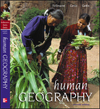
|  |
Features| Instructor contributions and suggestions are gratefully acknowledged by the content changes incorporated in this seventh edition. The basic structure of the book and its instructional philosophy and teaching aids have, however, been retained. The chapter title page "Focus Preview" alerting students to the three, four, or five main themes of the chapter and the summarizing "Focus Follow-up" section in the end-of-chapter material remain as does our use of map and photograph captions as teaching opportunities, conveying additional information and explanation as integral parts of the text.As in earlier editions of Human Geography, chapter introductions take the form of interest-arousing vignettes to focus student attention on the subject matter that follows. The boxed inserts that are part of each chapter expand on ideas included within the text proper or introduce related examples of chapter concepts and conclusions, often in gender-related contexts. Almost every chapter contains at least one special-purpose box labeled "Geography and Public Policy" introducing a discussion of a topic of current national or international interest and concluding with a set of questions designed to induce thought and class discussion of the topic viewed against the background of human geographic insights students have mastered. Increasingly for today's students, the learning process is electronically based. We have therefore included in each chapter a preliminary guide to Internet and World Wide Web sources of information related to the contents of the chapter. We do not pretend that the references given are exhaustive or represent the best sites currently available on the given topics; we hope, however, they will be useful starting points for student exploration and for instructor-supplied corrections and additions.This current edition of Human Geography continues our practice of identifying new terms and special usages of common words and phrases by boldface or italic type. Many of these are included in the Key Words list at the end of each chapter and defined in an inclusive cross-referenced glossary at the end of the text. Each chapter also includes other repeated pedagogical aids. Summary reiterates the main of the chapter and provides a bridge to the chapter that follows. For Review contains questions that direct student attention to important concepts developed within the chapter and that may serve, if the instructor chooses, as the basis for written assignments. Selected References suggests a number of book and journal articles that expand on topics presented within the chapter.Appendix B at the end of the book is a modified version of the Population Reference Bureau's 2001 World Population Data Sheet containing economic and demographic data and projections for countries, regions, and continents. Although inevitably dated, these provide a wealth of useful comparative statistics for student projects and study of world patterns. Finally, Appendix C, a single-page "Anglo American Reference Map," provides name identification of all U.S. states and Canadian provinces and showing the location of principal cities. |
|
|